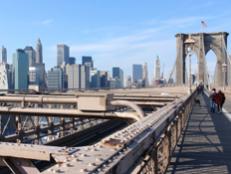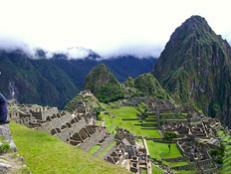Ecuador: What to See and Do
See Ecuador's popular cities and get our list of things to see and do.

By:
Valerie Conners
Cities to Visit
Quito's friendly locals, hearty foods, interesting colonial architecture and vibrant nightlife exemplify the Latin American spirit -- and make it a tough town for travelers to resist. Located high in the Andes Mountains, some 9,350 feet above sea level, the capital of Ecuador also happens to be the second highest capital city in the world. So visitors should be prepared to adjust to breathing the thin air.
Designated a World Heritage Site in 1978, 3 distinct regions divide Quito. The quick-to-charm Old Town is the central district and filled with colonial-style architecture and sites, including churches like the Iglesia de San Francisco. The southern district lays claim to modern high-rises and a vibrant commercial area. And the northern district is mostly industrial and residential.
Be sure to also visit the baroque-style church, La Compañía de Jesús, ride the cable car up the Pichincha Volcano and shop for local crafts at the Mercado Artesanal La Mariscal. When night falls head to La Mariscal neighborhood and salsa dance up a storm at one of the local bars.

Thinkstock
Cuenca, Ecuador
Tucked into a mountain valley at 8,000 feet, the largest city in Ecuador's southern highlands also enjoys World Heritage Site status, coupled with an interesting Incan history. Visitors will want to wander through the archaeological site Ingapirca, which includes ruins from Incan and pre-Incan eras.
While in town, visit Cuenca's many interesting churches, such as the Cuenca Cathedral located in the town's central plaza, and the 13th-century Iglesia de San Miguel. The town also houses a surprising number of small museums, including the Archaeological Museum, the Museum of Abstract Art and the Museum of Science of Castile-La Mancha. Don't miss one of the town's most jaw-dropping sites: Las Casas Colgadas, or "overhanging houses," a row of 14th-century homes that appear ready to tip over into the Huécar canyon.
Guayaquil
Ecuador's largest city -- more than 2 million Ecuadorians call it home -- is also its most modern, boasting innovative restaurants, high-end hotels, and the 9 de Octubre shopping district and pedestrian walkway. Still, a visit to this capital of commerce wouldn't be complete without stopping by the historic Las Peñas and Cerro Santa Ana neighborhoods. Reminiscent of old fishing villages, these areas have become mainstays of the arts scene, and are home to a number of trendy bars and art galleries.
Also be sure to make a trip to Malecón 2000, an urban renewal project that has transformed the banks of the Río Guayas River into a series of parks, ponds, playgrounds and river-viewing points. The area even houses a museum of anthropology and performance space. A number of large parks dot Guayaquil and are worth exploring, such as Parque Bolívar and the Parque Historico Guayaquil, which also doubles a zoo.
What to See and Do
Home to famed sea tortoises and the location that inspired Charles Darwin's theory of evolution, the Galapagos Islands mesmerize visitors with their stunning natural beauty. Located about 600 miles off the coast of Ecuador, the 13 large and 6 small Galapagos Islands have become a popular tour destination for travelers to the country, earning a reputation as a must-see attraction.
Plan to visit here via a tour -- it's the most convenient -- and expect to be dazzled by the Galapagos Islands’ native wildlife species, including penguins, sea lions, iguanas and albatrosses, which have thrived thanks to the islands' remote location and warm climate. Tourists can often swim alongside many of the animals, and it's wise to consider snorkeling as well for optimum sea-life viewing.
Hit the Beach at Montanita
Head to the freewheeling beach town of Montanita, a seaside village where some of Ecuador's hottest surfers congregate, topless sunbathing is tolerated and smoking marijuana happens openly. Like wandering into hippie heyday, visitors to Montanita will encounter bars blasting reggae music, same-sex couples walking hand-in-hand and electronica music festivals on the beach -- all anomalies in rather conservative Ecuador. Still Montanita serves primarily as a surfer haven; strong waves have lured in surfers, bodyboarders and windsurfers for years.

Jorge Andrade,flickr
Mitad del Mundo
Have some goofy fun taking photos of yourself straddling the equator line at Mitad del Mundo. Located just outside of Quito, it's the very spot where in 1736 explorers calculated the equatorial line, representing the middle of the planet and proving that the Earth is indeed round. Today, visitors have the option of visiting what has become a thriving tourist complex, complete with a museum, planetarium and a monument dedicated to the equator, and a painted yellow line depicting the point at which the equator would lie. Of course, as technology improved, it was discovered that the actual equator would lie just north of the Mitad del Mundo line. Still a visit to Ecuador -- meaning "Equator" in Spanish -- wouldn't be complete without a stop at La Mitad.
Devil's Nose Train Ride
Should you find yourself in Riobamba, a quaint town in central Ecuador, hop aboard the Devil's Nose train ride, an attraction that's quickly become an iconic Ecuador experience. The train ride zig-zags up a precipitous 330-foot cliff face, from Riobamba to the town of Sibambe, a hair-raising journey by all accounts. The Nariz del Diablo, or Devil's Nose, is actually a giant rock jutting from the slope, located between the 2 points. Trains leave at 7 a.m. and return around 5 p.m. Pro tip: Sit on the right side of the train for the best views.
Cuicocha Lake
Just north of Quito lies what might be Ecuador's most photographed body of water, the dramatic Cuicocha Lake, a 2-mile wide crater lake tucked into the caldera of the Cotacachi Volcano in the equatorial Andes. This stunning lake's bright blue waters will startle tourists with its unexpected beauty. Visitors can reach Cuicocha Lake via bus from the tiny town of Otavalo, then take a taxi from the town of Quiroga. Upon reaching the lake, it's possible to take a boat ride inside the caldera or hike the rim. Hikers beware, though: The terrain can be tricky and the elevation is high at 10,000 feet, which could make breathing a bit difficult.

Thinkstock
Cotopaxi National Park
Adventurous travelers to Ecuador will likely find their way to Cotopaxi National Park, 17 miles south of Quito, to climb the still-active, 19,347-foot Cotopaxi Volcano. Many tour agencies in Quito offer multiday trips to climb to the summit. These tours typically drop hikers off at a parking lot located around 14,700 feet, with a guided hike first to the "refuge" base camp 1,000 feet up. That’s where you'll stay overnight, and then head to the summit from there.
For novice climbers or simply those not interested in reaching the summit, consider one of the many tours that drop you off at the parking lot then take you on a guided hike to the refuge. Additionally, many companies offer bike tours that take you to the parking lot, guiding you down the volcano via bicycle.
Get Steamy in Banos de Agua Santa
The town of Banos de Agua Santa, located 100 miles south of Quito, lies adjacent to the Tungurahua Volcano and a jungle, giving it a stunning background setting. The area is also located in the midst of some of Ecuador's best adventure sports opportunities, as well as a number of natural hot springs and thermal pools.
Take a soothing dip in the mineral-rich waters, which have been heated by the volcano's springs, at popular spots such as La Piscina de La Virgen, Balneario Las Penas or Piscina El Salado. If soaking your cares away in hot springs gets dull, sign up for one of many adventure tours, including canyoneering, or climbing waterfalls, bridge jumping, hiking the volcano, white-water rafting or horseback riding.
What to Eat
First and foremost, eat your soup. Ecuadorians take their soups and stews seriously. So be sure to try the lentil stew, known as manestra, or the potato and cheese-based locro soup. Meats like chicken are commonly consumed, but be adventurous and try the cuy (roasted guinea pig) -- it's a common street food in parts of the country. The ceviche, or raw fish "cooked" and marinated in lime juice, is a delight in coastal cities. Also, you can't help but eat your potatoes; the potato is easily the most commonly found veggie in Ecuador, filling things like the empanadas and serving as side dishes or as part of stews.
In order to drink like a local, try one of the Ecuadorian pilsner-like beers or tree tomato juice, which is actually a sweet-and-sour fruit juice. Finally, if your sweet tooth kicks in, try the local flan, a custard-like caramel or coconut-flavored dessert.
Next Up
Hiking Vacations
We've selected 5 unforgettable hiking vacations sure to lead you into the thick of your destination.
Beyond Central Park: NYC's Green Spaces
See NYC's Top 5 parks other than famous Central Park.
10 Best Treks Around the World
See our picks for the top 10 hiking treks around world.
Best Historic Walking Tours in New York
Discover NYC's history, food, haunts and more. Check out our tips to help you explore NYC by foot.
Charleston Walking Tours
Explore Charleston's food, history, haunted spots and more.
Walking Paths in New York City
Take a stroll through NYC and discover some of the Big Apple's best walking paths.
Swimming With Sharks for Non-Divers
Dive into the details about which vacation spots are best suited for non-divers looking for an underwater adventure in and out of a shark cage.
Live-Aboard Scuba Dives
Read on for Travel Channel's picks for the best multiday dive trips.
Wildflower Hikes
Across the United States a number of hikes have become renowned for their annual display of wildflowers.
Backpackers' South America
Grab your pack, and discover South America.






































